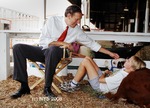A Question for Family Historians: Do Your Images Lead to Stories?
Biff Barnes
As you plan and organize your family history of memoir you should carefully review the photographs and images like documents and letters that you have. When you do you face a potential fork in the road. There are two ways you can proceed. Ask yourself, “Do I want my images to be the primary organizing principle to guide the narrative, or do the stories come first, with images supplementing my stories?”
When you consider the stories and images you have, you may decide to employ pictorial storytelling. Think about magazine like Life and Look or even Sports Illustrated, which used vivid pictures to tell a story. Text was used to supplement and explain the images. Or think about documentary photography like Dorthea Lange’ iconic depression photos which capture a time and place.

To create a pictorial history, choose the images first, and eliminate stories that are not tied directly to the illustrations.
When choosing your images consider the:
- The physical quality of the images. Are the photos faded, torn or scratched?
- The vividness of the story told by the photograph. Is it interesting enough?
Choose photographs that:
- Evoke laughter or cause emotion
- Are candid and show character

- Show stages of life; such as pictures of the same person taken years apart
- Are action shots; in general they’re more interesting than posed photos

- Are close-ups rather than long distance shots

- Are horizontal rather than vertical; these usually make better illustrations.
Documents tell important family stories. Including scanned images of old letters, diaries, birth or death records, property records, military records, marriage certificates and wills can add to the stories told by your photo collection.

